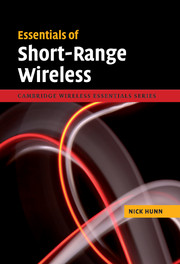Book contents
- Frontmatter
- Contents
- 1 Introduction
- 2 Fundamentals of short-range wireless
- 3 Wireless security
- 4 Bluetooth
- 5 IEEE 802.11abgn/Wi-Fi
- 6 IEEE 802.15.4, ZigBee PRO, RF4CE, 6LoWPAN and WirelessHART
- 7 Bluetooth low energy (formerly Wibree)
- 8 Application development – configuration
- 9 Application development – performance
- 10 Practical considerations – production, certification and IP
- 11 Implementation choices
- 12 Markets and applications
- Glossary of acronyms and abbreviations
- Index
- References
- Frontmatter
- Contents
- 1 Introduction
- 2 Fundamentals of short-range wireless
- 3 Wireless security
- 4 Bluetooth
- 5 IEEE 802.11abgn/Wi-Fi
- 6 IEEE 802.15.4, ZigBee PRO, RF4CE, 6LoWPAN and WirelessHART
- 7 Bluetooth low energy (formerly Wibree)
- 8 Application development – configuration
- 9 Application development – performance
- 10 Practical considerations – production, certification and IP
- 11 Implementation choices
- 12 Markets and applications
- Glossary of acronyms and abbreviations
- Index
- References
Summary
Wireless security may come as something of a shock to designers used to wires, where security is always assumed to be implicit. There, you connect a cable between two sockets, data are transferred and the assumption is that no one can or will intercept the signal. The wireless world is very different. Life is far more complex than it is within wired systems. Not only is there a question of ensuring that the correct devices (and only those correct devices) are connected to each other, but it is also much easier to intercept the wireless data stream, so that also needs to be secure.
Every wireless standard has started off with this knowledge and has produced specifications that attempt to provide security similar to that experienced with a wired system. Most failed to provide an adequate level of security, at least in their initial attempts. To a large degree, the blame for this can be levelled at governments, particularly the US Government. Until recently, there has been a level of paranoia about exporting any encryption technologies that made it difficult for security agencies to intercept and crack messages. As a result, standards bodies, particularly those based in the USA saw little point in writing security specifications that would have made the products that implemented them illegal to export. In more recent times, there has been a relaxation in export controls, allowing standards to embrace higher levels of security.
- Type
- Chapter
- Information
- Essentials of Short-Range Wireless , pp. 60 - 80Publisher: Cambridge University PressPrint publication year: 2010



